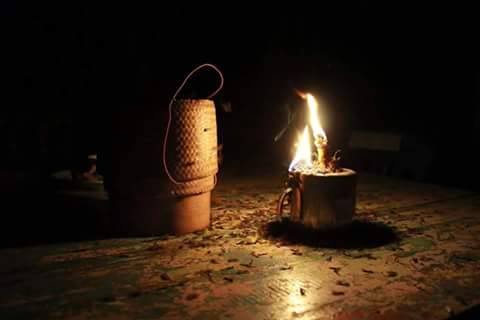|
Electricity came to the town of Prao in 1982. Prao is 100 kilometers north of Chiang Mai. Chiang Mai City alone had 24-hour electrical service in Chiang Mai Province in 1962. Most hill villages had just gotten electricity by 2002 and the grid was in place by then.
It was interesting in Prao that year, 1982. In the town there was a small electricity plant that ran on diesel fuel brought in barrels by truck. The electricity was on from dusk to about 10 p.m. High voltage lines were coming over the mountains to Prao that year. There were concrete electricity poles along the roadways to the nearby villages. Some buildings and homes in those villages had fans and fluorescent lights installed in readiness. Some homes had TVs that ran on car batteries, but the overall sense was anticipation. The era of electricity had not fully gotten to Prao by mid-year 1982, but it was there by Christmas. So what did people do before electricity? Illumination was the main need. Village life may thrive from sunup to sundown, but some people are up earlier and others go to bed later. Commerce and money were functional in the pre-electrification era, the “passing” era. During that time people used candles, coal-oil (kerosene) lamps and pressurized gas lamps. Flashlights were available but not cost-efficient for extended use. Those with special need and resources bought or rented gasoline powered electricity generators but they were noisy and expensive. In Prao every village home had a few kerosene lamps. The cheapest were made out of condensed milk cans with a metal tube soldered on to hold a wick (see the picture above). A better model was a lantern with a wide wick and glass globe. Candles made of paraffin were cheap and ubiquitous. But people went to bed before it got late. As for everything else that ran on electricity, village life did without most of that. Meat was butchered, sold fresh and consumed that day. Ice was available, brought from the city, a 3-hour trip (so you can guess how often village people had ice). Nigh-time village entertainment was sporadic, but very well attended because of its infrequency. As I remember, in Prao it consisted of likay folk drama productions by traveling troupes, Thai boxing matches, ram wong dances, and movies sponsored by soap companies. These were often part of a temple fair or fundraising/merit-making event. A funeral also necessitated accommodating a crowd at night. Pressurized gas lamps, called jao pa-yu (literally “storm lords”) provided light, and battery powered sound amplification set-ups helped the evening sermon be heard, although those who wanted to hear joined the inner crowd, while those on the outskirts gambled or fixed the refreshments that ended the evening. Jao pa-yu were almost always group purchases since they cost as much as a month’s salary in those days. The “passing era” of gas lamps, candles, and ice is mostly over now, and it’s as far back as most people can remember. But there was a time, completely “past”, when coal oil and metal lamps were not available. What did people use in those earlier times? According to the old people I asked, their grandparents made do with candles and bonfires. Kitchen areas had an open fire place where family gravitated. People carried little candles when they had to move around, and they took full advantage of natural light from the moon. Pine faggots also helped people see along dark pathways on the rare occasions they needed to go anywhere late at night. In this “present” time of full electrification I cannot accurately count the things in our house alone that run on electricity, although if the power goes out we turn on an emergency power supply to run the aerator pump for the fish tank, and we still have candles ready, along with flashlights. Did the coming of electricity make a major change in village culture? Yes and no. Yes, the era of rural electrification brought convenience, leisure time and extended possibilities. Yes, electricity became an instant necessity, requiring steady payments of money. Yes, electricity was an entire lifestyle package, including refrigerators, water pumps, home entertainment, and more. All this was more expensive that normal farm profits provided. Somebody had to work for a salary or the household lagged behind the neighbors. Social gaps widened. The village exodus began. So, yes electricity changed village culture. But the change was slow and incremental. As the profile of Prao in 1982 indicates, some electricity came years earlier than full electrification. People knew what to expect and actively worked for it. Early electricity bills were not onerous, roughly the same cost as petrol for a motorcycle per month. It did not seem as if life changed much. It just became easier.
0 Comments
Leave a Reply. |
AuthorRev. Dr. Kenneth Dobson posts his weekly reflections on this blog. Archives
March 2024
Categories |
| Ken Dobson's Queer Ruminations from Thailand |
|

 RSS Feed
RSS Feed
